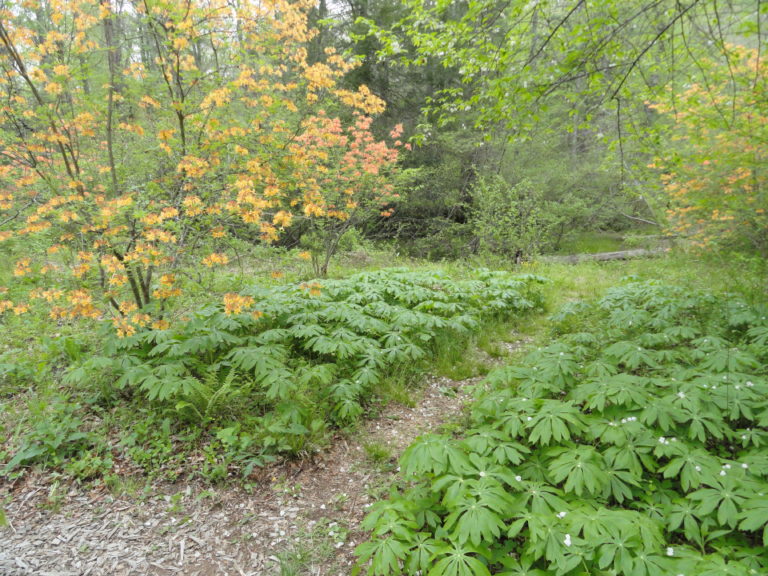The Mayapple is a foot-tall herbaceous perennial that grows in open mixed deciduous hardwood forests and alluvial woodlands and meadows in much of eastern U.S. It is valued for what it does best, which is to form dense colonies in part to full shade, usually from the rhizomes of a single plant, though it can also spread by seed. You would never know that these plants flower in April and May: they coyly hide their flowers, which are quite showy, away from general view under their palmately lobed, parasol-like foliage. Mayapple is a spring ephemeral, going dormant by mid- to late-summer and reappearing only the next spring. Turtles eat the fruit. The rhizome is known as Mandrake Root, and is sold on the internet for its “Magical attributes: protection, fertility, money, love, and health”.
NURSERY HOURS
Wednesday: 10-4 Thursday: 10-6 Friday-Saturday: 10-4 Sunday: 12-4
Podophyllum peltatum

Key Info
Scientific Name: Podophyllum peltatum L.
Common Names: Mayapple, Indian apple, Hog apple, Pomme de mai, Mandrake Root, American Mandrake, Wild Mandrake, Ground Lemon
Family Names: Berberidaceae (Barberry Family)
Plant Type: Herbaceous perennial
Bloom Times: May
Flower Color: White
Special Characteristics: Medicinal value, Spring ephemeral, Edible fruit (in jams), Rhizomatous, Tolerates dry conditions
Additional Info
Habit: Rhizomatous colony, usually from a single plant; each plant is comprised of either one or two upright stems topped by palmately lobed, ubrella-like leaf; no basal rosette.
Height: 1' - 1.5'
Spread: 1'
Soil Conditions: Rich, moist, humusy, well drained; acid-based, sandy, sandy loam, medium loam.
Leaves: Each plant rises 12-18 inches from the earth, with one or two deeply lobed palmately divided leaves supported like umbrellas.
Flowers (or reproductive structures: Plants with two leaves will bear one, 1-2-inch, nodding, white (sometimes pinkish), 6-9 petaled flower, terminal between the two leaves.
Fruit: The flower develops into a fleshy, yellow-green (sometimes red), edible seed pod ("apple"), technically a berry, in May/June and is desired by many forms of wildlife. The ripened fruit can be used to make preserves and jellies, though other plant parts are not so benign.
Natural Distribution: Open woods, shaded slopes in both moist and dry decidous woodlands.
USDA Hardiness Zone: 3 to 8
USDA Wetland Indicator Status in NC: FACU
Pollination: bees, butterflys, other insects
Wildlife Connections: Mayapple is obligately dependent upon soil mycorrhizae. The fruit is edible and highly desired by animals.
Propagation: The easiest way to propagate is by root division while the plant is dormant. Divide the rhizomes in fall with at least one bud. Seeds should be planted immediately or they will need to be treated.
